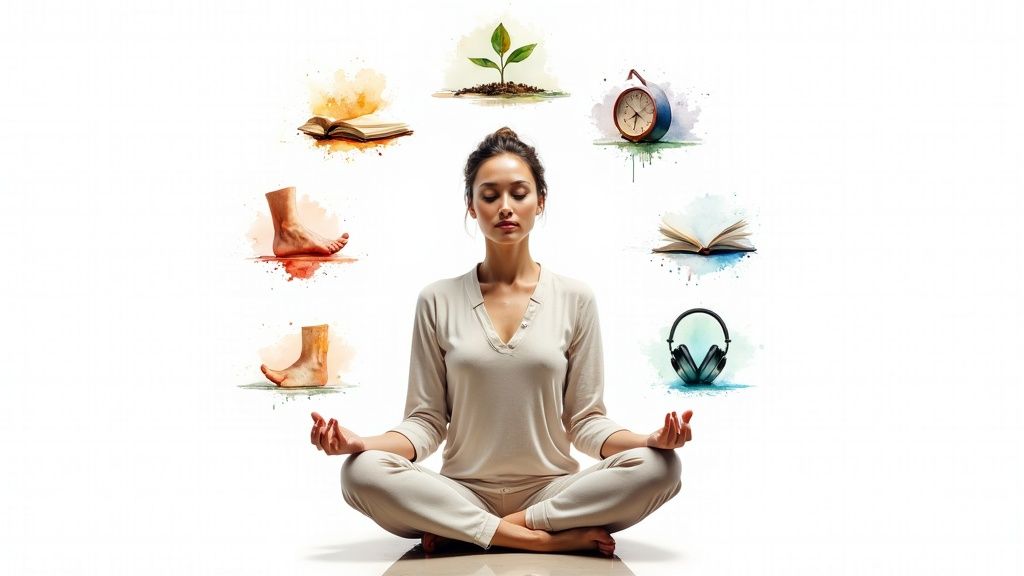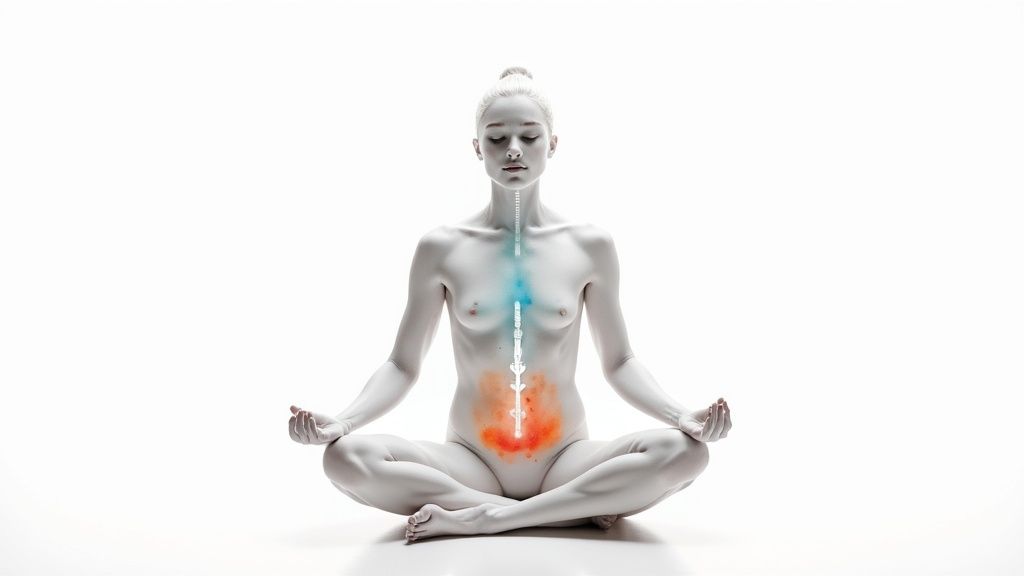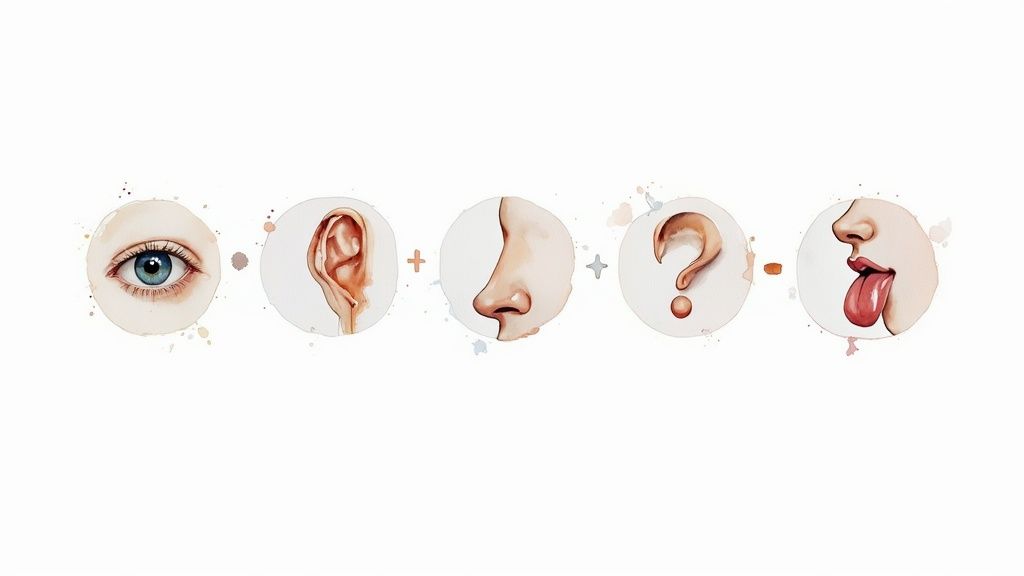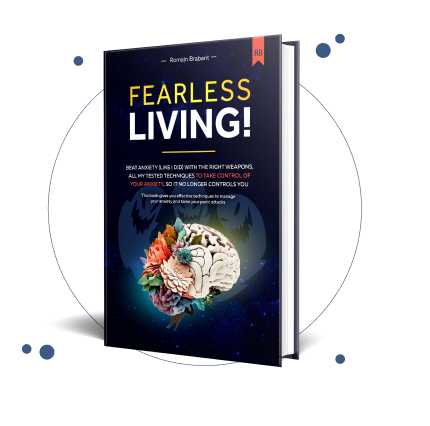
Feeling trapped in a cycle of worry, panic, and fear can be isolating, but you are not alone, and there is a clear path forward. Millions have learned to manage and overcome chronic anxiety, not by eliminating the emotion entirely, but by developing a toolkit of powerful anxiety coping skills. This is not about simply ‘calming down’; it is about fundamentally changing your relationship with anxiety and realizing that a calm, controlled, and joyful life is not just possible—it is attainable. True healing is within your reach, and the journey toward a panic-free life begins with understanding that you possess the strength to reclaim your peace.
This article is your practical roadmap. We will move beyond generic advice and delve into a comprehensive collection of actionable, evidence-based strategies that provide both immediate relief during moments of high stress and build long-term resilience against future panic. Consider this your personal guide to building a life where you are in control, not your anxiety.
Here, you will learn specific techniques like cognitive restructuring to challenge negative thought patterns, grounding exercises to pull you back to the present moment, and mindfulness practices to observe your feelings without judgment. Each skill is a stepping stone on your journey, empowering you to face challenges with newfound confidence. We will explore nine key strategies, including:
- Deep Breathing Exercises and Progressive Muscle Relaxation (PMR) for immediate physiological calm.
- Mindfulness Meditation and the 5-4-3-2-1 Grounding Method to anchor your awareness.
- Cognitive Restructuring and Expressive Journaling to reframe your thoughts.
- Lifestyle adjustments like Regular Exercise, Sleep Hygiene, and Social Connection to build a strong foundation for mental well-being.
By mastering these anxiety coping skills, you are not just managing symptoms; you are actively creating a more resilient, peaceful, and empowered version of yourself.
1. Deep Breathing Exercises
When anxiety spikes, your body enters a state of “fight or flight,” often leading to rapid, shallow breathing that can intensify feelings of panic. Deep breathing exercises are a powerful and foundational anxiety coping skill because they directly counteract this physiological response. By intentionally slowing and deepening your breath, you activate the parasympathetic nervous system, signaling to your brain that the danger has passed and it’s safe to relax.

This simple yet profound technique provides an anchor in the storm of anxious thoughts, offering immediate relief and a tangible sense of control. It’s a skill that gives hope, demonstrating that you have the power to regulate your body’s stress response and begin the journey to living panic-free.
How to Practice Deep Breathing
The core principle is to engage your diaphragm, the large muscle at the base of your lungs, rather than just your chest. This ensures a full, calming exchange of air.
- Box Breathing: Adopted by Navy SEALs to maintain focus under pressure, this method involves a simple, four-part cycle. Inhale for four seconds, hold your breath for four seconds, exhale for four seconds, and hold again for four seconds. Repeat this “box” pattern several times.
- 4-7-8 Breathing: Popularized by Dr. Andrew Weil, this technique is known for its tranquilizing effect. Inhale quietly through your nose for a count of four, hold your breath for a count of seven, and then exhale completely through your mouth for a count of eight, making a whooshing sound.
Practical Tips for Success
To make this one of your most effective anxiety coping skills, consistent practice is key.
- Practice When Calm: Don’t wait for a panic attack. Practicing daily when you feel calm builds muscle memory, making it easier to access the skill during high-stress moments.
- Use Your Hands as Guides: Place one hand on your belly and the other on your chest. As you inhale, focus on making your belly-hand rise while your chest-hand stays relatively still.
- Start with Guided Sessions: If your mind wanders, use a guided video or app to help you stay focused on the rhythm and count.
2. Progressive Muscle Relaxation (PMR)
Anxiety doesn’t just live in your mind; it creates a very real tension that gets stored in your body. Progressive Muscle Relaxation (PMR) is a powerful physical technique that directly tackles this bodily stress. By systematically tensing and then releasing different muscle groups, you learn to consciously distinguish between the feelings of tension and deep relaxation, giving you direct control over your body’s anxiety response.

This method, developed by Dr. Edmund Jacobson, offers a tangible path to calm. It proves that you can actively release the physical grip of anxiety, providing profound relief and building confidence in your ability to manage stress. This skill empowers you with the knowledge that you can find peace within your own body, a crucial step toward a life free from panic.
How to Practice PMR
The goal is to move sequentially through the body, isolating specific muscle groups to create a wave of relaxation from head to toe (or vice versa).
- Find a Quiet Space: Lie down or sit comfortably where you won’t be disturbed for about 15 minutes. Close your eyes and take a few deep breaths to begin.
- Tense and Release: Start with your feet. Curl your toes and tense the muscles in your feet for 5-10 seconds. Focus intently on the feeling of tightness. Then, abruptly release the tension and notice the difference for 10-20 seconds.
- Move Up the Body: Continue this tense-and-release sequence with other muscle groups: your calves, thighs, glutes, abdomen, chest, arms, hands, shoulders, neck, and face. With each release, feel the tension melting away.
Practical Tips for Success
Making PMR a regular habit is key to unlocking its full potential as one of your go-to anxiety coping skills.
- Focus on the Contrast: The most important part of the exercise is the sensation of release. Pay close attention to the feeling of warmth and looseness that follows the tension.
- Use a Script: When you’re first starting, following a guided audio or video script can help you stay on track and ensure you cover all the major muscle groups without getting distracted.
- Practice Before Bed: PMR is an excellent tool for combating anxiety-related insomnia. Practicing it in bed can help calm both your mind and body, preparing you for a restful night’s sleep.
3. Mindfulness Meditation
Anxiety often traps us in a cycle of “what if” scenarios, pulling our minds into a future filled with potential threats. Mindfulness meditation is an anxiety coping skill that directly addresses this by training you to anchor your awareness in the present moment. It involves observing your thoughts, feelings, and bodily sensations without judgment, which creates a crucial space between you and the anxiety itself, diminishing its power.

This practice cultivates a calm, non-reactive mindset, teaching you that you are not your anxious thoughts. By learning to watch them come and go like clouds in the sky, you build resilience and prove to yourself that it’s possible to find peace even when anxiety is present, paving the way to a more stable and panic-free life.
How to Practice Mindfulness Meditation
Pioneered by figures like Jon Kabat-Zinn, mindfulness is less about “emptying your mind” and more about gently redirecting your focus. The goal is gentle, consistent awareness.
- Seated Meditation: Find a comfortable, upright position. Close your eyes and bring your attention to the physical sensation of your breath entering and leaving your body. When your mind wanders, which it will, simply acknowledge the thought and gently guide your focus back to your breath.
- Mindful Observation: Choose a simple object in your environment, like a pen or a plant. Observe it as if for the first time, noticing its colors, textures, and shape without labeling or judging. This grounds you firmly in the present moment.
Practical Tips for Success
Making mindfulness a regular habit is key to unlocking its benefits as one of your core anxiety coping skills.
- Start Small: Begin with just 5 minutes a day. Consistency is more important than duration. As you become more comfortable, you can gradually increase the time.
- Use a Guide: Apps like Headspace or Calm, and countless free videos, provide guided meditations that can help keep you on track, especially when you are just starting out.
- Don’t Judge Your Thoughts: The goal is not to stop thinking. When your mind wanders to a worry, the practice is simply to notice it without criticism and return to your anchor (your breath). This act of gentle return is the core of the exercise. For an in-depth guide, you can learn more about how meditation helps with anxiety.
4. Cognitive Restructuring
Anxiety is often fueled by a loop of negative and irrational thoughts, creating a reality that feels threatening even when it isn’t. Cognitive restructuring is a foundational technique from Cognitive Behavioral Therapy (CBT) that empowers you to break this cycle. It involves identifying your anxious thoughts, challenging their validity, and actively replacing them with more balanced and realistic perspectives.

This method directly targets the mental engine of anxiety, giving you the tools to dismantle the very thought patterns that cause distress. By learning to question your fears instead of accepting them as fact, you reclaim authority over your mind. This is a crucial step toward realizing that you can live panic-free, armed with the ability to reshape your internal narrative.
How to Practice Cognitive Restructuring
The goal is to become a detective of your own thoughts, examining the evidence for and against them, much like a lawyer building a case. This process helps separate objective reality from anxiety-driven distortions.
- Catch the Thought: The first step is awareness. Notice when you feel a spike in anxiety and identify the specific thought that triggered it. For example, “I’m going to fail this presentation and everyone will think I’m incompetent.”
- Challenge the Thought: Once identified, question the thought’s accuracy. Ask yourself critical questions: What is the evidence that I will fail? Have I succeeded before? What is the worst that could really happen? What’s a more likely outcome?
- Change the Thought: Based on your challenge, formulate a more balanced and realistic thought. For example, “I’m nervous about my presentation, but I’ve prepared well. Even if I stumble on a few words, it’s not a catastrophe, and I can handle it.”
Practical Tips for Success
Making this one of your go-to anxiety coping skills requires turning it into a consistent habit.
- Use a Thought Record: Write it down. A simple journal or a dedicated worksheet where you log the situation, the anxious thought, the evidence, and the new balanced thought makes the process concrete and more effective.
- Practice with Small Worries: Start by challenging low-stakes anxieties. This builds your confidence and skill before you tackle bigger, more ingrained thought patterns.
- Seek Deeper Knowledge: Understanding the principles behind this technique can significantly enhance its effectiveness. For a comprehensive overview, you can learn more about the power of CBT for anxiety.
5. Grounding Techniques (5-4-3-2-1 Method)
When anxiety pulls you into a whirlwind of “what ifs” and worst-case scenarios, your mind can feel detached from reality, a key trigger for panic. Grounding techniques are powerful anxiety coping skills designed to pull you out of that chaotic internal storm and firmly anchor you in the present moment. By systematically engaging your five senses, you redirect your focus away from anxious thoughts and toward the safety and solidity of your immediate environment.
This method interrupts the anxiety spiral, proving that you can reclaim your attention from the grip of fear. It offers the empowering realization that even when your thoughts are racing, you possess a reliable, built-in tool to return to a place of calm and control, a critical step toward living a life free from panic.
How to Practice the 5-4-3-2-1 Method
This technique is a structured sensory journey that is simple to remember and can be done anywhere, anytime. The goal is to consciously notice your surroundings without judgment.
- 5 Things You Can See: Look around and name five distinct objects. A blue pen, a crack in the ceiling, a spinning fan, a framed picture, a dust bunny on the floor. Acknowledge each one’s color, shape, and texture.
- 4 Things You Can Feel: Notice four physical sensations. The soft fabric of your shirt against your skin, the solid pressure of your feet on the ground, the coolness of a metal desk, the gentle breeze from a vent.
- 3 Things You Can Hear: Listen carefully and identify three sounds. The distant hum of traffic, the ticking of a clock, the sound of your own steady breathing.
- 2 Things You Can Smell: Focus on what you can smell. The faint scent of coffee from the kitchen, the clean smell of soap on your hands. If you can’t identify a smell, imagine two of your favorite scents.
- 1 Thing You Can Taste: Identify one thing you can taste. The lingering mint from your toothpaste, a sip of water, or simply the neutral taste inside your mouth.
Practical Tips for Success
To make grounding one of your most reliable anxiety coping skills, integrate it into your life with intention.
- Practice When Calm: Rehearse the 5-4-3-2-1 sequence when you are not anxious. This builds familiarity and makes it an automatic reflex during moments of high stress.
- Be Descriptive (Internally): Don’t just list items; describe them to yourself. Instead of “a chair,” think “a sturdy, brown wooden chair with a smooth finish.” This deepens your engagement with the present moment.
- Combine with Breathing: Before starting, take one or two deep, deliberate breaths. This can lower the initial intensity of the anxiety, making it easier to focus on the grounding exercise.
6. Regular Exercise and Physical Activity
When you’re caught in a cycle of anxiety, your body is often flooded with stress hormones like cortisol and adrenaline, creating a restless, nervous energy. Regular exercise and physical activity are among the most effective anxiety coping skills because they provide a powerful, natural outlet for this tension. By engaging your body, you can metabolize stress hormones, release mood-boosting endorphins, and reduce anxiety’s physical symptoms.
This proactive approach does more than just burn off stress; it builds resilience and a profound sense of self-efficacy. Each workout is a victory, a tangible demonstration that you can take control of your well-being, providing a powerful source of hope that a life free from the grip of panic is not only possible but achievable. As Dr. John Ratey has shown in his research, moving your body is one of the best things you can do for your brain.
How to Practice Physical Activity
The goal is to move your body consistently in a way that feels good to you, rather than seeing it as a punishment or chore. This shifts the focus from aesthetics to mental and emotional relief.
- Aerobic Exercise: Activities like brisk walking, jogging, cycling, or swimming elevate your heart rate and are incredibly effective at reducing anxiety. A landmark Harvard study found that just 30 minutes of daily walking could reduce symptoms of anxiety by a significant margin.
- Mindful Movement: Practices like yoga or tai chi combine physical postures, breathing exercises, and meditation. These are excellent for reducing both the physical tension and the mental chatter that fuel anxiety.
Practical Tips for Success
Integrating exercise as one of your primary anxiety coping skills requires consistency, not intensity.
- Start Small: Don’t feel you need to run a marathon. Begin with a 10-15 minute walk each day and gradually increase the duration as you feel more comfortable.
- Find Your Joy: Choose an activity you genuinely enjoy. If you hate running, don’t force it. Try dancing, hiking, team sports, or rock climbing. Enjoyment is the key to long-term success.
- Track Your Mood, Not Just Metrics: Pay attention to how you feel mentally and emotionally before and after you exercise. Noticing the immediate mood lift is a powerful motivator to keep going.
7. Journaling and Expressive Writing
Anxious thoughts often swirl in a chaotic loop, feeling overwhelming and inescapable. Journaling and expressive writing offer a structured way to get these thoughts out of your head and onto paper, breaking the cycle of rumination. This act of externalizing your worries engages your brain’s prefrontal cortex, the area responsible for reasoning and emotional regulation, helping to calm the more reactive, fear-driven parts of your mind.
This process transforms abstract fears into concrete words, making them feel more manageable and less threatening. It’s a powerful anxiety coping skill that provides clarity and insight, giving you hope by demonstrating that you can untangle complex emotions and find a path forward, one page at a time, toward a life free from panic’s grip.
How to Practice Journaling
The goal is not to create a literary masterpiece but to create a safe space for honest self-reflection. The key is finding a method that resonates with you and allows for consistent practice.
- Pennebaker’s Expressive Writing: Based on research by Dr. James Pennebaker, this technique involves writing about your deepest thoughts and feelings surrounding a stressful event for 15-20 minutes over several consecutive days. The focus is purely on emotional release and processing.
- Anxiety Tracking Journal: Use a simple notebook or a system like the Bullet Journal, pioneered by Ryder Carroll, to track your anxiety. Note the date, time, anxiety level (e.g., 1-10), triggers, physical sensations, and the thoughts you were having. This helps identify patterns you might otherwise miss.
- Morning Pages: Popularized by Julia Cameron in “The Artist’s Way,” this involves writing three pages of stream-of-consciousness thoughts first thing in the morning. It’s a “brain dump” designed to clear mental clutter and reduce anxiety for the day ahead.
Practical Tips for Success
To turn journaling into one of your most reliable anxiety coping skills, focus on consistency over perfection.
- Set a Timer: Commit to writing for just 15-20 minutes. Knowing there’s an end point makes it less intimidating to start.
- Forget Grammar and Spelling: This is for your eyes only. Write freely without censoring yourself or worrying about mistakes. The goal is expression, not perfection.
- Include Physical Sensations: When describing an anxious moment, don’t just write about your thoughts. Note the tightness in your chest, the churning in your stomach, or the shakiness in your hands. This creates a more complete picture for later review.
8. Establishing Consistent Sleep Hygiene
The relationship between sleep and anxiety is a vicious cycle: anxiety disrupts sleep, and poor sleep amplifies anxiety. Establishing consistent sleep hygiene refers to creating a set of habits and a bedroom environment that are conducive to high-quality, restorative sleep. This practice is one of the most powerful anxiety coping skills because it directly addresses the biological foundation of emotional regulation. Quality sleep helps regulate stress hormones like cortisol and improves the brain’s ability to process emotions, making you less reactive to anxious triggers.
By prioritizing sleep, you are not just resting your body; you are actively equipping your mind with the resilience it needs to manage anxiety. This commitment gives you a profound sense of control and demonstrates that healing is possible, offering a clear path toward a calmer mind and a life free from the grip of panic.
How to Practice Sleep Hygiene
The goal is to send consistent, powerful signals to your brain that it’s time to wind down and rest. This concept has been championed by experts like Dr. Matthew Walker and organizations such as the National Sleep Foundation.
- Create a Bedtime Ritual: Design a 30-60 minute “wind-down” routine. This could include reading a physical book, gentle stretching, listening to calm music, or taking a warm bath. The consistency is key.
- Optimize Your Environment: Turn your bedroom into a sleep sanctuary. It should be cool (around 65°F or 18°C), completely dark (use blackout curtains), and quiet. The bed should be used only for sleep and intimacy.
Practical Tips for Success
Making this one of your core anxiety coping skills requires commitment, but the payoff is immense.
- Maintain a Strict Schedule: Go to bed and wake up at the same time every day, even on weekends. This stabilizes your body’s internal clock, or circadian rhythm, making it easier to fall asleep and wake up naturally.
- Mind Your Light Exposure: Avoid bright screens (phones, tablets, TVs) for at least an hour before bed, as the blue light suppresses melatonin production. Conversely, get exposure to bright, natural light first thing in the morning to signal wakefulness.
- Watch What You Consume: Avoid caffeine and large meals late in the evening. While alcohol might make you feel drowsy initially, it disrupts sleep architecture later in the night, reducing sleep quality.
9. Social Support and Connection
Anxiety can be profoundly isolating, making you feel like you are facing your fears alone. Building and nurturing a strong social support network is one of the most effective anxiety coping skills because it directly combats this loneliness. Meaningful connections with others provide validation, perspective, and a crucial reminder that you are not broken, offering a powerful buffer against the overwhelming nature of stress and panic.
This sense of belonging is more than just a feeling; it has a biological impact. Positive social interactions can trigger the release of oxytocin, a hormone that promotes bonding and reduces levels of the stress hormone cortisol. This skill provides hope by showing that healing from anxiety doesn’t have to be a solitary battle; a community can provide the strength and encouragement needed to live panic-free.
How to Practice Social Support and Connection
Engaging with others can seem daunting when anxiety is high, but even small, intentional steps can create powerful momentum. The goal is to cultivate relationships where you feel seen, heard, and accepted.
- Support Groups: Joining a group specifically for anxiety disorders, either in-person or online, connects you with people who truly understand what you’re experiencing. Sharing stories and strategies in a safe space can be incredibly validating.
- Workplace Peer Support: Many organizations now have formal or informal peer support programs. Connecting with a colleague who can offer a listening ear during a stressful workday provides immediate, on-the-spot relief.
- Online Communities: If face-to-face interaction feels too intense, forums and moderated social media groups dedicated to anxiety management offer a low-pressure way to find camaraderie and practical advice from a global community.
Practical Tips for Success
To make this one of your most reliable anxiety coping skills, focus on quality over quantity and be proactive in your efforts.
- Maintain Regular Contact: Don’t wait until a crisis hits. Schedule regular check-ins, calls, or meetups with trusted friends and family to keep your connections strong and active.
- Be Selective: Not all relationships are supportive. Invest your limited energy in people who lift you up, listen without judgment, and respect your boundaries. It’s okay to distance yourself from draining or negative influences.
- Practice Reciprocal Support: A healthy support system is a two-way street. Offering support to others when you are able can strengthen your bonds and reinforce your own sense of competence and connection.
Anxiety Coping Skills Comparison Matrix
| Method | Implementation Complexity 🔄 | Resource Requirements ⚡ | Expected Outcomes 📊 | Ideal Use Cases 💡 | Key Advantages ⭐ |
|---|---|---|---|---|---|
| Deep Breathing Exercises | Low 🔄 | Minimal ⚡ (none) | Immediate physiological relief 📊 | Quick anxiety relief, panic prevention | Instant effect, accessible, no cost |
| Progressive Muscle Relaxation | Moderate 🔄 | Low ⚡ (quiet space) | Physical tension reduction, improved sleep 📊 | Generalized anxiety, physical stress | Effective for physical symptoms, side-effect free |
| Mindfulness Meditation | Moderate 🔄 | Low ⚡ (time, guided apps) | Long-term emotional regulation and resilience 📊 | Anxiety management, emotional regulation | Builds self-awareness, research-backed |
| Cognitive Restructuring | High 🔄 | Moderate ⚡ (time, practice) | Long-term anxiety reduction 📊 | Anxiety disorders, cognitive distortions | Addresses root cause, empowering |
| Grounding Techniques (5-4-3-2-1) | Low 🔄 | Minimal ⚡ (none) | Immediate anxiety interruption 📊 | Panic attacks, acute anxiety episodes | Quick, easy to remember, no equipment |
| Regular Exercise & Physical Activity | Moderate 🔄 | Moderate ⚡ (time, space) | Reduced anxiety, improved mood, sleep 📊 | Ongoing anxiety management, resilience building | Multiple health benefits, mood booster |
| Journaling & Expressive Writing | Low 🔄 | Minimal ⚡ (time, pen & paper) | Increased self-awareness, emotional processing 📊 | Emotional clarity, anxiety tracking | Low cost, therapeutic, insightful |
| Establishing Consistent Sleep Hygiene | Moderate 🔄 | Low ⚡ (discipline needed) | Improved emotional regulation and sleep quality 📊 | Chronic anxiety affected by poor sleep | Natural, enhances overall health |
| Social Support & Connection | Moderate 🔄 | Variable ⚡ (time, social effort) | Reduced anxiety and depression risk 📊 | Emotional support, reducing isolation | Strong natural buffer, enhances resilience |
Your Personalized Toolkit for a Fearless Life
Navigating the landscape of anxiety can often feel like an overwhelming, isolating journey. You’ve just explored a comprehensive map of nine powerful, evidence-based anxiety coping skills, each one a distinct tool designed to empower you. From the immediate calm of Deep Breathing and the 5-4-3-2-1 Grounding technique to the long-term resilience built through Cognitive Restructuring and consistent Sleep Hygiene, these are not just abstract concepts. They are practical, actionable strategies that can fundamentally change your relationship with anxiety.
The core message to take away is one of profound hope: healing is possible. Living a life free from the grip of chronic anxiety and panic is not a distant dream reserved for others. It is an achievable reality, and the skills detailed in this article are the building blocks for that reality. The path forward is not about finding a single, magical cure, but about thoughtfully assembling your own personalized toolkit.
Weaving Skills into the Fabric of Your Life
The true power of these anxiety coping skills is unlocked through consistent practice and integration. Think of it less like a frantic search for an emergency exit during a panic attack and more like a daily commitment to building a stronger, more resilient foundation.
- Start Small, Build Momentum: Don’t try to master all nine skills at once. Choose one or two that resonate most with you. Perhaps it’s committing to a five-minute Progressive Muscle Relaxation session before bed or using a journaling prompt to untangle your thoughts each morning.
- Practice When You’re Calm: The best time to learn how to use a fire extinguisher is not when the building is on fire. Similarly, practicing grounding techniques or deep breathing when you are relatively calm wires these responses into your nervous system. This makes them more accessible and automatic when you truly need them.
- Combine for Greater Impact: These skills work synergistically. After a tough day, you might use Regular Exercise to burn off nervous energy, followed by Expressive Writing to process the day’s events, and finally, Mindfulness Meditation to settle your mind before sleep. This layering of coping mechanisms creates a robust defense against anxiety’s intrusion.
The journey to managing anxiety is a testament to your strength. Every time you choose to take a deep breath instead of spiraling, challenge a negative thought, or reach out to your social support network, you are actively reclaiming your power. It is an act of profound self-compassion and a step towards a life defined not by fear, but by freedom and presence.
Embracing the Process with Self-Compassion
Remember that progress is rarely linear. There will be days when your anxiety feels more intense, and your coping skills may seem less effective. These are not failures; they are data points. They are opportunities to get curious, to ask yourself what you need in that moment, and to practice self-kindness.
Your goal is not to eliminate anxiety forever. The goal is to build the confidence that you can handle it whenever it arises.
This shift in perspective is transformative. It moves you from a position of fearing anxiety to a position of trusting in your ability to cope. You have the tools. You have the capacity. Embrace this journey with patience, celebrate the small victories, and know that with each conscious effort, you are paving the way to a more peaceful, fearless, and fulfilling life. You are not just surviving; you are learning to thrive.
Ready to transform these skills into a systematic, actionable plan? The Anxiety Checklist integrates these proven techniques into a comprehensive 93-point interactive program, guiding you step-by-step from understanding your triggers to building a resilient, panic-free life. Take control of your healing journey today by visiting The Anxiety Checklist.

